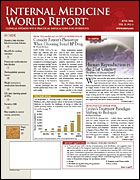Publication
Article
Internal Medicine World Report
Investigational Biologic Increases Bone Mass
Author(s):
An estimated 10 million Americans have osteoporosis and another 34 million have low bone massthat puts them at increased risk for osteoporosis, thus news of potentially effective new treatment options is always welcomed by physicians and patients.
New England Journal of Medicine
Results from a recent phase 2 study published in the (2006;354:821-831) showed that twice-yearly injections of the investigational agent denosumab (formally known as AMG 162; Amgen), a nuclear factor kB ligand (RANKL) inhibitor, increased bone mineral density (BMD) in the total hip, lumbar spine, distal one third of the radius, and total body compared with placebo.
The 1-year study included 412 postmenopausal women (median age, 63 years) with low BMD, 90% (369) of whom completed the study. Participants were randomly assigned to denosumab every 3 months (6, 14, or 30 mg) or every 6 months (14, 60, 100, or 210 mg), open-label alendronate (Fosamax) once weekly (70 mg), or placebo.
At study onset, average lumbar T scores ranged from ?2.0 to ?2.2 across all dosage groups, which was consistent with a diagnosis of osteopenia. Approximately one fourth of the women had osteoporosis, defined as a T score ≤?2.5 at the lumbar spine.
P
Subcutaneous injections of denosumab increased BMD at the total hip by 1.9% to 3.6% in women who received therapy twice yearly compared with a 0.6% decrease in the placebo group (<.001) at 1 year. The open-label alendronate arm had an increase of 2.1%. Denosumab had a rapid onset of action and decreased serum levels of C-telopeptide, a biomarker of bone resorption, within 72 hours after dosing.
P
P
P
Twice-yearly subcutaneous injections of denosumab also increased lumbar spine BMD by 3.0% to 6.7% after 12 months compared with a decrease of 0.8% in the patients receiving placebo ( <.001). Across all dosages and dosing intervals, BMD at the distal one third of the radius increased by 0.4% to 1.3% as compared with a decrease of 2% in those receiving placebo ( <.001); total body BMD increased by 0.6% to 2.8% compared with a decrease of 0.2% in the placebo group ( <.01).
The incidence of adverse events was similar among the placebo, the 3/6 months denosumab, and the alendronate groups, with the exception of dyspepsia, which occurred in 7%, 6% to 15%, and 26% of patients, respectively. The most common side effects in all groups were upper respiratory tract infection, arthralgia, nasopharyngitis, back pain, and headache.
Led by Michael R. McClung, MD, of Providence Portland Medical Center, Portland, Ore, the investigators concluded that "doses of 30 mg of denosumab every 3 months and 60 mg every 6 months provided maximal biologic effect at the minimum exposure."





